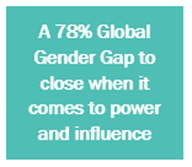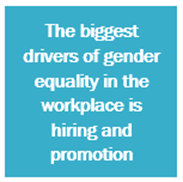Equality in leadership - the Gender Gap
Your HR processes can support the 5th UN Sustainable Development Goal – Gender Equality - do they?
The 5th Sustainable Development Goal is to achieve gender equality and empower all women and girls. Part of this goal is to “provide women and girls with equal access to education, health care, decent work and representation in political and economic decision-making process to fuel sustainable economies and benefit societies and humanity at large” (extract from the 5th Goal”). With only ten years left to achieve the UN Sustainable Development Goals accelerated progress is needed to deliver the set Goals by 2030 and to do so, organizations must be assertive about gender diversity and have gender diversity as an integral part of their business strategies. Progress is being made in many places, but not advancing at the speed required.
From the article: The Best-Performing CEO’s in the World 2019 published in Harvard Business Review, Nov.-Dec. 2019, it is evident that women are unrepresented among the best performing leaders in the world (top 100). The article states “that it is not a result of the performance of female CEOs, but a result of how few women serve the role”.
Gender gap in the workplace anno 2019
World Economic Forum’s annual Global Gender Gap Report (2018) provides a comprehensive overview of the current state of the global gender gap and of efforts and insights to close it. The report reveals that the Global Gender Gap score stands at 68%, meaning that on average, there is still a 32% gap to close. Data predicts that on a global scale it will require 108 years on average to achieve full parity. Even though the good news is that the gaps between men and women on a global scale are getting smaller there is still a large gap when it comes to measures of power and influence. On this measure the Global Gender Gap Score stands at 22% with a 78% gap to close.
The Global Gender Gap report offers a clear message to policymakers and organizations that countries that wish to remain competitive and inclusive must work hard to create gender equality in the workplace. Greater educational equality does not do it alone.


Closing the gender gap in hiring and promotions
It is evident from the data that managerial opportunities for women are particularly uneven across countries and nations. Even though there is an increasing presence of women in corporate and political leadership roles, women are still under-represented on C-suite level and on company boards.
Inequality is often related to stereotyped gender expectations and beliefs about attributes about women and men, which prescribe how men and women ought to be. The stereotyped masculine construct of leadership can explain less favorable attitudes toward females on the C-suite.

Recruiters are uniquely positioned to make an immediate positive impact and to promote greater diversity and inclusivity in the workplace. A good place to start is at entry and manager-level employees to make real progress. Inequality on this level has a profound impact on the talent pipeline. One action to take is to ensure that recruitment practices and metrics are fair to both genders and to minimize unconscious situational judgement bias:
- Ensure diverse and inclusive interview panels
- Assemble and evaluate gender-balanced candidate pools
- Apply analytics to measure progress and track gender related metrics in the organization
- Apply objective assessment measures to evaluate person-job fit
- Ensure fairness in assessment measures – gender balanced
- Use analytics to drive gender equality
- Apply candidate sourcing and recruiting solutions that are gender fair
Performance reviews play a key role in opportunities for promotion in many organizations. For equal opportunities to attain influential leadership positions this is critical since studies show, that there is a gap in performance reviews of female leaders, which negatively impacts perception of female effectiveness (Cecchi-Dimeglio 2017). One explanation is that these reviews are often subjective in nature and open for gender bias. Another is, that gender bias is often built into performance evaluation methods. E.g. Rivera & Tilcsik (2019) has found profound gender bias in evaluations using a 10-point rating scale. Even small changes to existing practices and methods can minimize subjective bias and promote female leadership on both the interpersonal and organizational level:
- Apply more objective criteria
- Ensure gender diverse group of reviewers
- Apply gender neutral wording
- Adjust frequency of reviews and engage in real-time communication and instant feedback
- Apply evaluations with gender fair rating options

Globally there is a wide variance in the advancement and progression when it comes to closing the gender gap in relation to measures of power and influence. Beyond doubt, everybody and not just women will benefit from transparent hiring, evaluation and promotion procedures. Attention to applied hiring and promotion practices can positively impact both financial but also environmental and social outcomes.
External Lecturer DIS Copenhagen, Industrial-Organizational Psychologist, Louise Bergøe
References:
Cecchi-Dimeglio, P. 2017: How gender bias corrupts performance reviews, and what to do about it. In HBR, April 12. 2017.
Northouse G.P. (2019): Leadership Theory and Practice: SAGE Publications. Chp.15. pp. 349-375.
Rivera & Tilcsik 2019, One Way to Reduce Gender Bias in Performance Reviews. In HBR, April 2019
World Economic Forum: The Global Gender Gap Report 2018.
Women in the Workplace 2018, a study undertaken by LeanIn.Org and McKinsey. It builds on the Women in the Workplace reports from 2015, 2016, and 2017.





